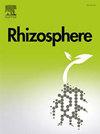Crop domestication has increased phosphorus-acquisition capacity but restricted root plasticity under phosphorus-limited conditions
IF 3.4
3区 生物学
Q1 PLANT SCIENCES
引用次数: 0
Abstract
Crop domestication marks a crucial milestone in human civilization, yet our understanding of the changes in belowground crop traits, specifically those associated with phosphorus (P)-acquisition strategies, during domestication remains limited. Ten crop species and their wild relatives were grown under both P-sufficient (40 mg P kg−1) and P-deficient (nil-P added) conditions to compare the biomass, P content and P-acquisition strategies related to root morphological and physiological traits. Domesticated crops presented a lower specific root length and acid phosphatase activity but greater arbuscular mycorrhizal (AM) colonization, more root-secreted carboxylates per plant, and higher values for root morphological traits such as root length than their wild relatives. Domesticated crops showed a 79 % higher P content than their wild relatives under P-deficient conditions, associated with a greater root length, AM-colonization rate and root-secreted carboxylates per plant in domesticated crops. Domesticated crops displayed significantly greater plasticity (shown as response ratio) in AM colonization rate, but lower plasticity in specific root length, acid phosphatase activity, and amount of root-secreted carboxylates per plant than their wild relatives in response to low plant-available soil P concentrations. Crop domestication increased P-acquisition capacity by combining P-scavenging and P-mining strategies but largely restricted root plasticity, specifically in P-acquisition strategies. We confirmed trade-offs among P-scavenging strategies related to soil exploration and P-mining strategies related to root-secreted carboxylates. Our results highlight the domestication effects on crop P-acquisition strategies mediated by plant-soil interaction, providing insights to further improve crop P-acquisition efficiency.
在限磷条件下,作物驯化提高了磷吸收能力,但限制了根系的可塑性
作物驯化标志着人类文明的一个重要里程碑,然而我们对作物地下性状的变化,特别是与驯化过程中磷(P)获取策略相关的性状的了解仍然有限。研究了10种作物及其野生近缘种在富磷(40 mg P kg−1)和缺磷(零磷)条件下的生物量、磷含量以及与根系形态和生理性状相关的磷获取策略。驯化作物的比根长和酸性磷酸酶活性较低,但丛枝菌根(AM)定植量较大,单株根分泌羧酸含量较高,根长等根系形态特征值高于野生近缘种。在缺磷条件下,驯化作物的磷含量比其野生亲缘品种高79%,这与驯化作物的根长、am定植率和单株根分泌羧酸有关。驯化作物在AM定植率方面表现出显著的可塑性(以响应比表示),但在比根长、酸性磷酸酶活性和单株根分泌羧酸盐数量方面,驯化作物对低植物有效磷浓度的响应低于野生作物。作物驯化通过清除磷和挖掘磷的组合策略提高了磷的获取能力,但在很大程度上限制了根系的可塑性,特别是磷的获取策略。我们确认了与土壤勘探相关的磷清除策略和与根分泌羧酸盐相关的磷开采策略之间的权衡。本研究结果强调了植物-土壤相互作用介导的驯化对作物磷素获取策略的影响,为进一步提高作物磷素获取效率提供了见解。
本文章由计算机程序翻译,如有差异,请以英文原文为准。
求助全文
约1分钟内获得全文
求助全文
来源期刊

Rhizosphere
Agricultural and Biological Sciences-Agronomy and Crop Science
CiteScore
5.70
自引率
8.10%
发文量
155
审稿时长
29 days
期刊介绍:
Rhizosphere aims to advance the frontier of our understanding of plant-soil interactions. Rhizosphere is a multidisciplinary journal that publishes research on the interactions between plant roots, soil organisms, nutrients, and water. Except carbon fixation by photosynthesis, plants obtain all other elements primarily from soil through roots.
We are beginning to understand how communications at the rhizosphere, with soil organisms and other plant species, affect root exudates and nutrient uptake. This rapidly evolving subject utilizes molecular biology and genomic tools, food web or community structure manipulations, high performance liquid chromatography, isotopic analysis, diverse spectroscopic analytics, tomography and other microscopy, complex statistical and modeling tools.
 求助内容:
求助内容: 应助结果提醒方式:
应助结果提醒方式:


